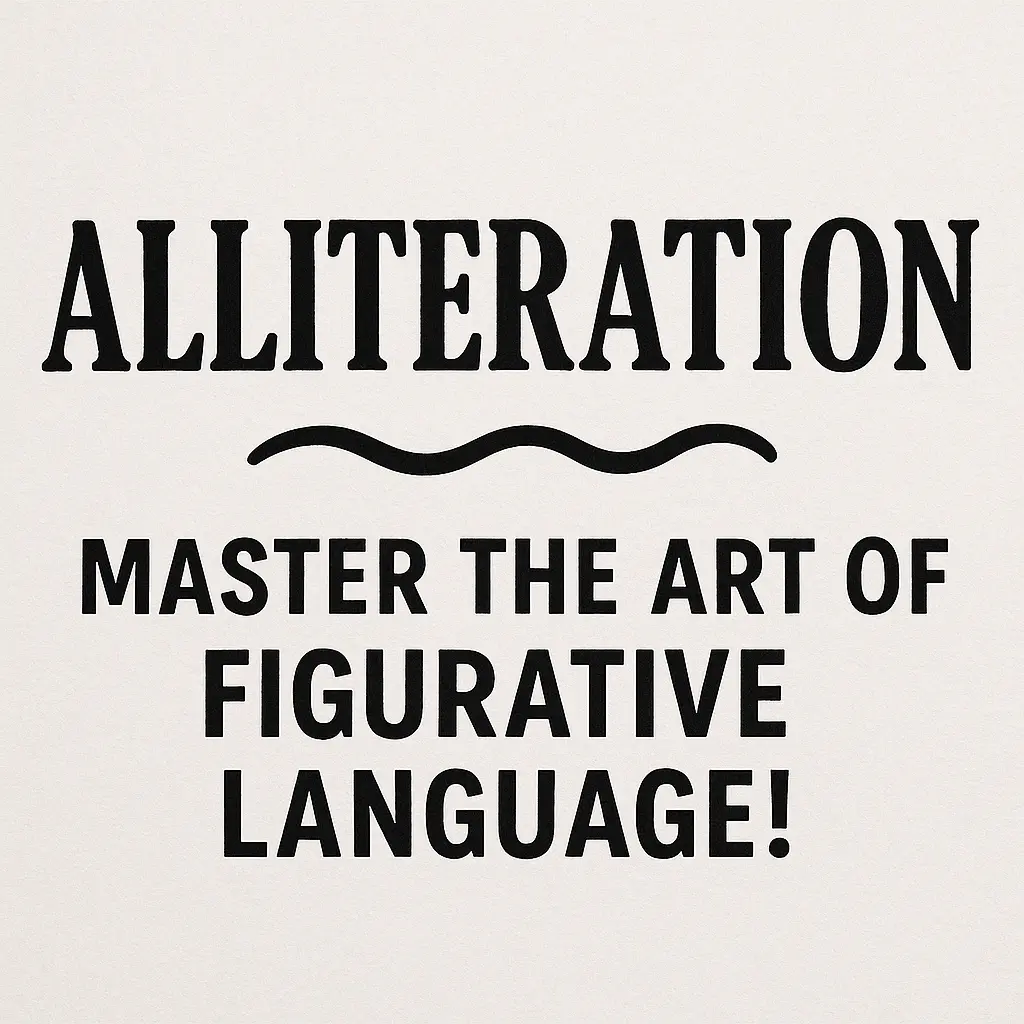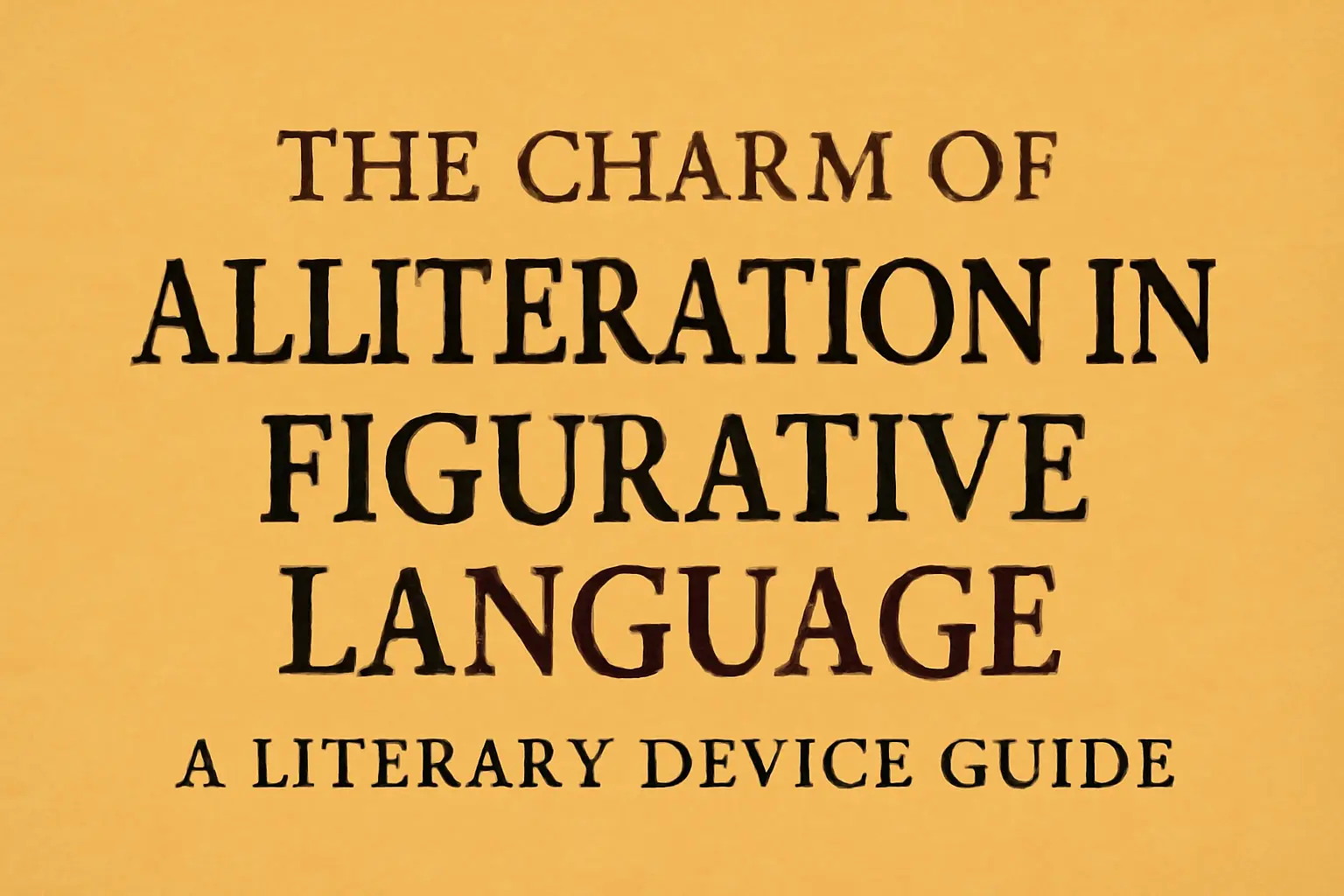Introduction: Understanding Alliteration in Figurative Language
Alliteration in figurative language is a literary device where the initial consonant sounds of words are repeated in close succession. This repetition creates a rhythmic flow, making the language more engaging and memorable. Alliteration is commonly used in poetry, literature, and even in everyday speech to emphasize specific ideas or create a sense of harmony.
In literature and poetry, alliteration helps to draw attention to particular words or themes, enhancing the overall emotional or aesthetic impact. It can evoke certain moods, amplify the rhythm of the lines, and make the writing more fluid and enjoyable to read. Writers use this device to ensure that their work resonates with readers, making it both memorable and appealing.
This article aims to explore the significance of alliteration in figurative language. By examining its role in enriching writing, readers will gain a deeper understanding of how this powerful literary tool enhances meaning and adds charm to language. Through examples and insights, this guide will showcase how alliteration can elevate both simple and complex writing styles.
What is Alliteration? A Deep Dive
Alliteration in figurative language refers to the repetition of consonant sounds at the beginning of words. This simple yet powerful literary device creates rhythm and enhances the flow of writing. For example, phrases like “She sells seashells by the seashore” or “Peter Piper picked a peck of pickled peppers” are common examples of alliteration in everyday language.
In literature, alliteration is often used to emphasize certain phrases or evoke specific emotions. It can make a poem or story more engaging and memorable. When combined with other figurative language devices like metaphors or similes, alliteration helps to create a more vivid and impactful narrative. Alliteration’s connection to figurative language is essential in storytelling, as it enriches the writing, drawing the reader’s attention to key moments and enhancing the overall experience.
The Role of Alliteration in Figurative Language
Alliteration in figurative language plays a key role in strengthening the overall impact of a piece of writing. By repeating consonant sounds, alliteration enhances the rhythm and musicality of the language, making it more engaging. This repetition helps emphasize specific themes, ideas, or emotions, drawing the reader’s attention to important aspects of the narrative.
For example, in the metaphor “The silent sea sang softly,” alliteration not only reinforces the image of the sea but also heightens the sense of calmness and tranquility. Similarly, in a simile like “As fierce as a fiery fox,” alliteration intensifies the comparison. Alliteration can also work well with personification, as seen in “The wind whispered through the trees,” where it gives life to the inanimate. By incorporating alliteration, writers can make their figurative language more vivid and impactful.

Types of Alliteration in Figurative Language
In figurative language, alliteration comes in different forms, each with a unique impact on the text. One common distinction is between consonance and assonance. Consonance refers to the repetition of consonant sounds, like in “pitter-patter,” while assonance is the repetition of vowel sounds, such as “fate and made.” Both are similar to alliteration but focus on different parts of the sound.
Another type of alliteration is internal alliteration, where the repeated sounds appear within words, not just at the beginning. For example, in the phrase “bitter-sweet” or “middle-morning,” the repetition of sounds adds depth and flow to the language.
End alliteration occurs when consonant sounds repeat at the end of words, influencing the rhythm of a sentence. This technique adds a different layer of emphasis, creating a unique cadence in writing. Each type enhances figurative language and helps writers craft more engaging and memorable narratives.
Types of Alliteration in Figurative Language: Consonance, Assonance, Internal & End Alliteration
Consonance and Assonance
In figurative language, alliteration comes in different forms, each with a unique impact on the text. One common distinction is between consonance and assonance. Consonance refers to the repetition of consonant sounds, like in “pitter-patter,” while assonance is the repetition of vowel sounds, such as “fate and made.” Both are similar to alliteration but focus on different parts of the sound.
Internal Alliteration
Another type of alliteration is internal alliteration, where the repeated sounds appear within words, not just at the beginning. For example, in the phrase “bitter-sweet” or “middle-morning,” the repetition of sounds adds depth and flow to the language.
End Alliteration
End alliteration occurs when consonant sounds repeat at the end of words, influencing the rhythm of a sentence. This technique adds a different layer of emphasis, creating a unique cadence in writing. Each type enhances figurative language and helps writers craft more engaging and memorable narratives.
Famous Literary Examples of Alliteration in Figurative Language
Alliteration in figurative language has been widely used in both classic literature and modern works to enhance storytelling and rhythm. One of the most famous examples is from Edgar Allan Poe’s “The Raven”:
“Once upon a midnight dreary, while I pondered, weak and weary.”
The repetition of the “w” sound creates a haunting, rhythmic quality that complements the eerie mood of the poem. Another well-known example is in the tongue-twister “Peter Piper picked a peck of pickled peppers,” where alliteration amplifies the playful nature of the phrase.
In Shakespeare’s “Macbeth,” the line “Fair is foul, and foul is fair” uses alliteration to emphasize the theme of moral ambiguity and set a rhythm that echoes throughout the play.
These examples show how alliteration strengthens the emotional impact and rhythmic flow of writing, making it memorable and engaging for readers.
Benefits of Alliteration in Figurative Language
Rhythmic Appeal
Alliteration in figurative language adds rhythmic appeal, giving the text a musicality and flow that enhances the reader’s experience. The repetition of consonant sounds creates a pleasing, almost melodic quality that draws readers in and makes the writing more enjoyable to read.
Memorability
One of the key benefits of alliteration is its ability to improve memorability. The repetition of sounds makes phrases and lines stick in readers’ minds. This is why famous alliterative phrases, like “Peter Piper picked a peck of pickled peppers,” are so easy to recall.
Evoking Emotions
Alliteration can also evoke emotions by intensifying the emotional impact of the writing. The repetition of specific sounds can amplify the tone or mood, making the narrative feel more powerful and resonating deeply with the reader’s emotions.
How Writers Can Use Alliteration in Figurative Language
Practical Tips for Writers
Writers can use alliteration in figurative language to enhance their writing by focusing on key words or phrases that benefit from repetition. Choosing words with similar consonant sounds at the beginning can create a catchy rhythm. Writers should aim to incorporate alliteration in titles, metaphors, or descriptions to make their writing more memorable.
Avoiding Overuse
To avoid overuse, writers should ensure that alliteration doesn’t distract from the message or disrupt the flow of the narrative. It’s important to use it sparingly, only where it serves the story or theme, to avoid making the writing feel forced or artificial.
Example Exercises
Writers can practice creating figurative language with alliteration by rewriting simple sentences with alliterative phrases. For example, change “The cat sat on the mat” to “The curious cat crept cautiously.” These exercises help writers refine their skill in using alliteration effectively in their work.
The Impact of Alliteration in Speech and Advertising
Alliteration in Public Speaking and Advertising
Alliteration in figurative language is a powerful tool in public speaking and advertising. Speakers and marketers use it to grab attention and create a rhythm that makes their message more engaging and memorable. For example, famous speeches often use alliteration to emphasize key points and evoke strong emotions.
Catchy Slogans and Memorable Phrases
Alliteration is commonly found in catchy slogans and brand names because it makes phrases easier to remember. Think of phrases like “Better buy, better brand” or “Coca-Cola’s classic taste.” The repetition of sounds creates a memorable and enjoyable experience, helping brands stick in the audience’s mind. Alliteration enhances the appeal of advertisements, making them more effective in leaving a lasting impression.
Common Mistakes to Avoid When Using Alliteration in Figurative Language
Overuse of Alliteration
One common mistake when using alliteration in figurative language is overuse. While alliteration can enhance writing, too much repetition of consonant sounds can distract the reader. Writers should avoid relying on alliteration excessively, as it can make the text feel forced and reduce its impact.
Forced or Unnatural Alliteration
Another pitfall is using forced or unnatural alliteration. When the repetition of sounds feels awkward or out of place, it can break the flow of the text and disrupt the reader’s experience. Alliteration should feel natural and add to the overall tone of the writing, not hinder it.
Balancing Alliteration with Other Literary Devices
To ensure alliteration enhances the text, writers should balance it with other literary devices like metaphors, similes, and personification. Using a variety of devices allows the writing to remain fresh and engaging, while preventing alliteration from overwhelming the narrative.
Conclusion: The Lasting Power of Alliteration in Figurative Language
Alliteration plays a crucial role in enhancing the beauty of figurative language by adding rhythm, musicality, and emphasis to writing. It helps to make language more engaging, memorable, and emotionally resonant. Whether in literature, poetry, or everyday speech, alliteration draws attention to key ideas and creates a sense of flow that captivates the reader or listener.
Its importance extends beyond written words, as alliteration also impacts spoken communication, including public speeches and advertisements, where it makes phrases catchy and memorable. Writers, speakers, and marketers alike benefit from its power to influence and captivate.
Writers are encouraged to explore and experiment with alliteration in their creative endeavors. By understanding its potential and using it effectively, they can enhance their storytelling, making their language more vibrant and impactful.

